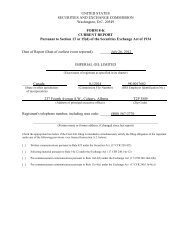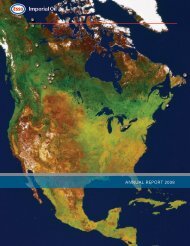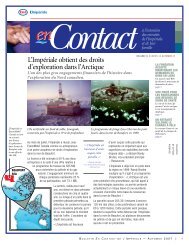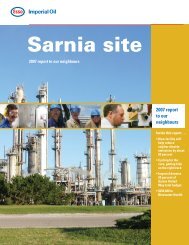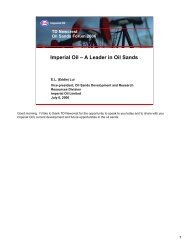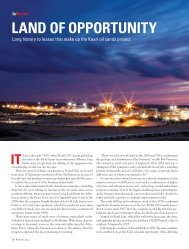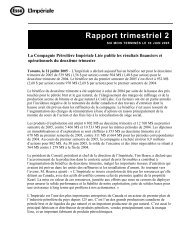FORM 10-K IMPERIAL OIL LIMITED
FORM 10-K IMPERIAL OIL LIMITED
FORM 10-K IMPERIAL OIL LIMITED
Create successful ePaper yourself
Turn your PDF publications into a flip-book with our unique Google optimized e-Paper software.
8. Other long-term obligations<br />
millions of dollars 2004 2003<br />
Employee retirement benefits (note 7) (a) 1 052 847<br />
Asset retirement obligations and other environmental liabilities ( b ) 380 393<br />
Other obligations 93 74<br />
Total other long-term obligations 1 525 1 314<br />
( a ) Total re c o rded employee re t i rement benefits obligations also include $48 million in current liabilities (2003 – $44 million).<br />
( b ) Total asset re t i rement obligations and other environmental liabilities also include $76 million in current liabilities (2003 – $69 million). The estimated<br />
cash flows of asset re t i rement obligations have been discounted at six percent. The total undiscounted amount of the estimated cash flows re q u i re d<br />
to settle the obligations is $970 million. Payments to settle the obligations occur on an ongoing basis and will continue over the lives of the operating<br />
assets, which can exceed 25 years. The change in asset re t i rement obligations liability is as follows:<br />
millions of dollars 2 0 0 4 2 0 0 3<br />
Asset re t i rement obligations liability at January 1 327 341<br />
A d d i t i o n s 16 –<br />
A c c re t i o n 22 20<br />
S e t t l e m e n t ( 37 ) ( 34 )<br />
Asset re t i rement obligations liability at December 31 3 2 8 3 2 7<br />
9. Derivatives and financial instruments<br />
No significant energy derivatives, foreign-exchange forward contracts or currency and interest-rate swaps were transacted in the past<br />
three years. The company maintains a system of controls that includes a policy covering the authorization, reporting and monitoring of<br />
derivative activity.<br />
The fair value of the company’s financial instruments is determined by re f e rence to various market data and other appropriate valuation<br />
techniques. There are no material diff e rences between the fair values of the company’s financial instruments and the re c o rded book value.<br />
<strong>10</strong>. Incentive compensation programs<br />
Incentive compensation programs are designed to retain selected employees, reward them for high performance and promote individual<br />
contributions to sustained improvement in the company’s future business performance and shareholder value.<br />
Incentive share units, deferred share units, earnings bonus units and restricted stock units<br />
Incentive share units have value if the market price of the company’s common shares when the unit is exercised exceeds the market value<br />
when the unit was issued. The issue price of incentive share units is the closing price of the company’s shares on the To ronto Stock<br />
Exchange on the grant date. Up to 50 percent of the units may be exercised after one year from issuance; an additional 25 percent may be<br />
e x e rcised after two years; and the remaining 25 percent may be exercised after three years. Incentive share units are eligible for exerc i s e<br />
up to <strong>10</strong> years from issuance. The units may expire earlier if employment is terminated other than by re t i rement, death or disability.<br />
The deferred share unit plan is made available to selected executives and nonemployee directors. The selected executives can elect to<br />
receive all or part of their performance bonus compensation in units, and the nonemployee directors can elect to receive all or part of<br />
their directors’ fees in units. The number of units granted to executives is determined by dividing the amount of the bonus elected to be<br />
received as deferred share units by the average of the closing prices of the company’s shares on the Toronto Stock Exchange for the<br />
five consecutive trading days immediately prior to the date that the bonus would have been paid. The number of units granted to a<br />
nonemployee director is determined at the end of each calendar quarter by dividing the amount of directors’ fees for the calendar quarter<br />
that the nonemployee director elected to receive as deferred share units by the average closing price of the company’s shares for the<br />
five consecutive trading days immediately prior to the last day of the calendar quarter. Additional units are granted based on the cash<br />
dividend payable on the company’s shares divided by the average closing price immediately prior to the payment date for that dividend<br />
and multiplying the resulting number by the number of deferred share units held by the recipient.<br />
Deferred share units cannot be exercised until after termination of employment with the company or resignation as a director and must<br />
be exercised no later than December 31 of the year following termination or resignation. On the exercise date, the cash value to be<br />
received for the units is determined based on the average closing price of the company’s shares for the five consecutive trading days<br />
immediately prior to the date of exercise.<br />
The earnings bonus unit plan is available to selected executives. Each earnings bonus unit entitles the recipient to receive an amount<br />
equal to the company’s cumulative net earnings per common share as announced each quarter beginning after the grant. Payout occurs<br />
on the fifth anniversary of the grant or when the maximum settlement value per unit is reached, if earlier. Earnings bonus units may<br />
expire if employment is terminated other than by death or disability.<br />
F-16



